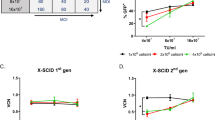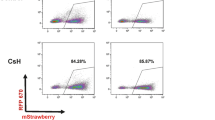Abstract
A major problem limiting hematopoietic stem cell (HSC) gene therapy is the low efficiency of gene transfer into human HSCs using retroviral vectors. Strategies, which would allow in vivo expansion of gene-modified hematopoietic cells, could circumvent the problem. To this end, we developed a selective amplifier gene (SAG) consisting of a chimeric gene composed of the granulocyte colony-stimulating factor (G-CSF) receptor gene and the estrogen receptor gene hormone-binding domain. We have previously demonstrated that primary bone marrow progenitor cells transduced with the SAG could be expanded in response to estrogen in vitro. In the present study, we evaluated the efficacy of the SAG in the setting of a clinically applicable cynomolgus monkey transplantation protocol. Cynomolgus bone marrow CD34+ cells were transduced with retroviral vectors encoding the SAG and reinfused into each myeloablated monkey. Three of the six monkeys that received SAG transduced HSCs showed an increase in the levels of circulating progeny containing the provirus in vivo following administration of estrogen or tamoxifen without any serious adverse effects. In one monkey examined in detail, transduced hematopoietic progenitor cells were increased by several-fold (from 5% to 30%). Retroviral integration site analysis revealed that this observed increase was polyclonal and no outgrowth of a dominant single clonal population was observed. These results demonstrate that the inclusion of our SAG in the retroviral construct allows selective in vivo expansion of genetically modified cells by a non-toxic hormone treatment.
This is a preview of subscription content, access via your institution
Access options
Subscribe to this journal
Receive 12 print issues and online access
$259.00 per year
only $21.58 per issue
Buy this article
- Purchase on Springer Link
- Instant access to full article PDF
Prices may be subject to local taxes which are calculated during checkout




Similar content being viewed by others
References
Dunbar CE et al. Retrovirally marked CD34-enriched peripheral blood and bone marrow cells contribute to long-term engraftment after autologous transplantation Blood 1995 85: 3048–3057
Hanazono Y, Dunbar CE . Genetic marking Forman SJ, Blume KG, Thomas ED (eds); Hematopoietic Cell Transplantation Blackwell Science 1999 pp 89–96
Hanazono Y, Terao K, Ozawa K . Gene transfer into nonhuman primate hematopoietic stem cells: implications for gene therapy Stem Cells 2001 19: 12–23
Sorrentino BP et al. Selection of drug-resistant bone marrow cells in vivo after retroviral transfer of human MDR1 Science 1992 257: 99–103
Hanania EG et al. Results of MDR-1 vector modification trial indicate that granulocyte/macrophage colony-forming unit cells do not contribute to posttransplant hematopoietic recovery following intensive systemic therapy Proc Natl Acad Sci USA 1996 93: 15346–15351
Hesdorffer C et al. Phase I trial of retroviral-mediated transfer of the human MDR-1 gene as marrow chemoprotection in patients undergoing high-dose chemotherapy and autologous stem-cell transplantation J Clin Oncol 1998 16: 165–172
Moscow JA et al. Engraftment of MDR1 and NeoR gene-transduced hematopoietic cells after breast cancer chemotherapy Blood 1999 94: 52–61
Abonour R et al. Efficient retrovirus-mediated transfer of the multidrug resistance 1 gene into autologous human long-term repopulating hematopoietic stem cells Nat Med 2000 6: 652–658
Chaudhary PM, Roninson IB . Expression and activity of P-glycoprotein, a multidrug efflux pump, in human hematopoietic stem cells Cell 1991 66: 85–94
Drach D et al. Subpopulations of normal peripheral blood and bone marrow cells express a functional multidrug resistance phenotype Blood 1992 80: 2729–2734
Blau CA, Neff T, Papayannopoulou T . Cytokine prestimulation as a gene therapy strategy: implications for using the MDR1 gene as a dominant selectable marker Blood 1997 89: 146–154
Sorrentino BP, McDonagh KT, Woods D, Orlic D . Expression of retroviral vectors containing the human multidrug resistance 1 cDNA in hematopoietic cells of transplanted mice Blood 1995 86: 491–501
Bunting KD et al. Transduction of murine bone marrow cells with an MDR1 vector enables ex vivo stem cell expansion, but these expanded grafts cause a myeloproliferative syndrome in transplanted mice Blood 1998 92: 2269–2279
Allay JA et al. Retroviral transduction and expression of the human alkyltransferase cDNA provides nitrosourea resistance to hematopoietic cells Blood 1995 85: 3342–3351
Jelinek J et al. Long-term protection of hematopoiesis against the cytotoxic effects of multiple doses of nitrosourea by retrovirus-mediated expression of human O6-alkylguanine-DNA-alkyltransferase Blood 1996 87: 1957–1961
Spencer HT et al. A gene transfer strategy for making bone marrow cells resistant to trimetrexate Blood 1996 87: 2579–2587
Allay JA et al. In vivo selection of retrovirally transduced hematopoietic stem cells Nat Med 1998 4: 1136–1143
Ito K et al. Development of a novel selective amplifier gene for controllable expansion of transduced hematopoietic cells Blood 1997 90: 3884–3892
Blau CA, Peterson KR, Drachman JG, Spencer DM . A proliferation switch for genetically modified cells Proc Natl Acad Sci USA 1997 94: 3076–3081
Richard RE et al. Expansion of genetically modified primary human hematopoietic cells using chemical inducers of dimerization Blood 2000 95: 430–436
Clackson T et al. Redesigning an FKBP-ligand interface to generate chemical dimerizers with novel specificity Proc Natl Acad Sci USA 1998 95: 10437–10442
Jin L et al. In vivo selection using a cell-growth switch Nat Genet 2000 26: 64–66
Matsuda KM et al. Development of a modified selective amplifier gene for hematopoietic stem cell gene therapy Gene Therapy 1999 6: 1038–1044
Xu R et al. A selective amplifier gene for tamoxifen-inducible expansion of hematopoietic cells J Gene Med 1999 1: 236–244
Picard D . Regulation of protein function through expression of chimaeric proteins Curr Opin Biotechnol 1994 5: 511–515
Kume A et al. Expansion of transduced murine hematopoietic cells with selective amplifier genes Mol Ther 2001 3: S249
Yoshikawa A, Murakami H, Nagata S . Distinct signal transduction through the tyrosine-containing domains of the granulocyte colony-stimulating factor receptor EMBO J 1995 14: 5288–5296
Littlewood TD et al. A modified oestrogen receptor ligand-binding domain as an improved switch for the regulation of heterologous proteins Nucleic Acids Res 1995 23: 1686–1690
Duke GM, Hoffman MA, Palmenberg AC . Sequence and structural elements that contribute to efficient encephalomyocarditis virus RNA translation J Virol 1992 66: 1602–1609
Heim DA et al. Introduction of a xenogeneic gene via hematopoietic stem cells leads to specific tolerance in a rhesus monkey model Mol Ther 2000 1: 533–544
Dunbar CE et al. Improved retroviral gene transfer into murine and rhesus peripheral blood or bone marrow repopulating cells primed in vivo with stem cell factor and granulocyte colony-stimulating factor Proc Natl Acad Sci USA 1996 93: 11871–11876
Tajima F, Sato T, Laver JH, Ogawa M . CD34 expression by murine hematopoietic stem cells mobilized by granulocyte colony-stimulating factor Blood 2000 96: 1989–1993
Tisdale JF et al. Ex vivo expansion of genetically marked rhesus peripheral blood progenitor cells results in diminished long-term repopulating ability Blood 1998 92: 1131–1141
Kiem HP et al. Improved gene transfer into baboon marrow repopulating cells using recombinant fibronectin fragment CH-296 in combination with interleukin-6, stem cell factor, FLT-3 ligand, and megakaryocyte growth and development factor Blood 1998 92: 1878–1886
Klug CA, Cheshier S, Weissman IL . Inactivation of a GFP retrovirus occurs at multiple levels in long-term repopulating stem cells and their differentiated progeny Blood 2000 96: 894–901
Zitvogel L et al. Construction and characterization of retroviral vectors expressing biologically active human interleukin-12 Hum Gene Ther 1994 5: 1493–1506
Holli K et al. Safety and efficacy results of a randomized trial comparing adjuvant toremifene and tamoxifen in postmenopausal patients with node-positive breast cancer J Clin Oncol 2000 18: 3487–3494
Nolta JA et al. Transduction of pluripotent human hematopoietic stem cells demonstrated by clonal analysis after engraftment in immune-deficient mice Proc Natl Acad Sci USA 1996 93: 2414–2419
Kim HJ et al. Many multipotential gene-marked progenitor or stem cell clones contribute to hematopoiesis in nonhuman primates Blood 2000 96: 1–8
Licht T, Herrmann F, Gottesman MM, Pastan I . In vivo drug-selectable genes: a new concept in gene therapy Stem Cells 1997 15: 104–111
James RI et al. Mild preconditioning and low-level engraftment confer methotrexate resistance in mice transplanted with marrow expressing drug-resistant dihydrofolate reductase activity Blood 2000 96: 1334–1341
Davis BM, Koc ON, Gerson SL . Limiting numbers of G156A O6-methylguanine-DNA methyltransferase-transduced marrow progenitors repopulate nonmyeloablated mice after drug selection Blood 2000 95: 3078–3084
Bestor TH . Gene silencing as a threat to the success of gene therapy J Clin Invest 2000 105: 409–411
Zeng H et al. Receptor specificity in the self-renewal and differentiation of primary multipotential hemopoietic cells Blood 2001 98: 328–334
Rosenzweig M et al. Induction of cytotoxic T lymphocyte and antibody responses to enhanced green fluorescent protein following transplantation of transduced CD34+ hematopoietic cells Blood 2001 97: 1951–1959
Pear WS, Nolan GP, Scott ML, Baltimore D . Production of high-titer helper-free retroviruses by transient transfection Proc Natl Acad Sci USA 1993 90: 8392–8396
Hanazono Y, Yu J-M, Dunbar CE, Emmons RVB . Green fluorescent protein retroviral vectors: low titer and high recombination frequency suggest a selective disadvantage Hum Gene Ther 1997 8: 1313–1319
Hanenberg H et al. Colocalization of retrovirus and target cells on specific fibronectin fragments increases genetic transduction of mammalian cells Nat Med 1996 2: 876–882
Acknowledgements
We thank F Ono, H Narita and K Hanari for handling and care of monkeys. We thank JF Tisdale for critical reading of the manuscript. We are grateful to I Kato for supplying RetroNectin. We acknowledge Nippon Kayaku's supply of toremifene, Amgen's supply of SCF, Ajinomoto's supply of IL-6, Chugai's supply of G-CSF, and Kirin's supply of IL-3 and thrombopoietin. This study was supported by the Ministry of Education, Culture, Sports, Science and Technology of Japan (YH and KO), the Ministry of Health, Labor and Welfare of Japan (KO), CREST of Japan Science and Technology Corporation (KO), Takeda Science Foundation (KO), Japan Medical Association (KO), Yamanouchi Foundation for Research on Metabolic Disorders (KO), Jichi Medical School Young Investigator Award (YH), the Mochida Memorial Foundation for Medical and Pharmaceutical Research (YH), and Senri Life Science Foundation (YH).
Author information
Authors and Affiliations
Rights and permissions
About this article
Cite this article
Hanazono, Y., Nagashima, T., Takatoku, M. et al. In vivo selective expansion of gene-modified hematopoietic cells in a nonhuman primate model. Gene Ther 9, 1055–1064 (2002). https://doi.org/10.1038/sj.gt.3301781
Received:
Accepted:
Published:
Issue Date:
DOI: https://doi.org/10.1038/sj.gt.3301781
Keywords
This article is cited by
-
Hematopoietic stem cell gene therapy with drug resistance genes: an update
Cancer Gene Therapy (2005)
-
Expansion of genetically corrected neutrophils in chronic granulomatous disease mice by cotransferring a therapeutic gene and a selective amplifier gene
Gene Therapy (2004)
-
Selective Expansion of Transduced Cells for Hematopoietic Stem Cell Gene Therapy
International Journal of Hematology (2002)



